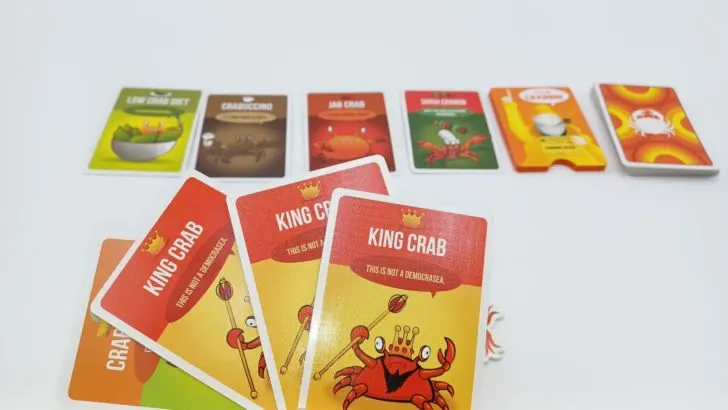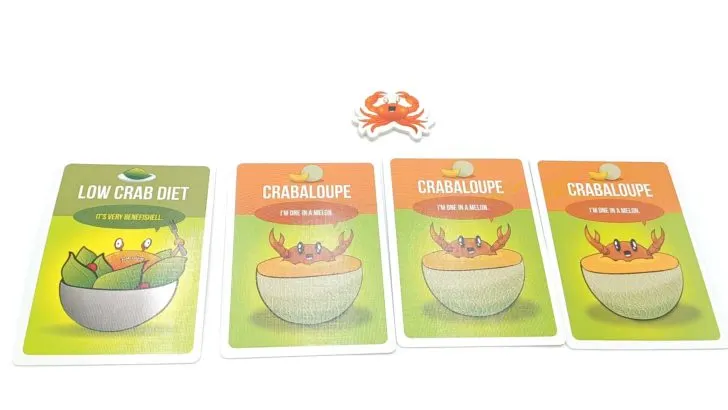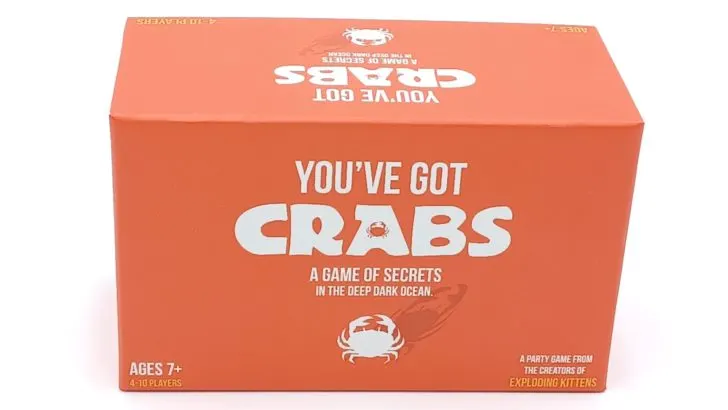Objective of You’ve Got Crabs
The objective of You’ve Got Crabs is to catch more crabs than the other teams by the end of the game.
Setup for You’ve Got Crabs
- Divide into teams of two.
- Before the game each team should come up with non-verbal signals/clues that they will use during the game to indicate to their teammate that they have collected four crab cards of the same type. When coming up with these signals you must follow these rules:
- You can’t use words, numbers or anything vocal for your clue.
- You must use signals that the other players could potentially see. For example no touching your teammate under the table.
- If your signal feels like it is cheating, it is considered cheating.
- Each player should sit diagonally across the table from their partner. You don’t need to be exactly diagonal from one another, but there should be some space so all of the players can potentially see when you exchange signals with your teammate.
- Divide the table into two sides. There should be one player from each team on each side.
- If there are only two or three teams, choose two types of Crab cards. Remove all of the cards from those two types of cards.
- Shuffle the deck. Deal four cards face down to each player.
- Place the remaining cards face down on the table. This will be the Draw Pile.
- Put the Crabbing License next to the Draw Pile.
- Take the top four cards from the Draw Pile and turn them face up next to the Crabbing License. This forms “The Ocean”.
- Each team takes two Crab Tokens. Place eight Crab Tokens in the middle of the table to form the Crab Pot. If there are extra Crab Tokens, return them to the box.
- Choose one of the two sides of the table to go first. You can choose whatever side you want. Point the Crabbing License towards the chosen side.

Playing You’ve Got Crabs
The objective of the game is to try and get four Crab Cards of the same type in your hand at the same time.
All of the players on the current side of the table will play at the same time. There are no turns. You may play as quickly or as slowly as you want.
Once the round begins all of the players on the current side can start exchanging the cards from their hand with those in the Ocean. To take a card from the Ocean you must replace it with a card from your hand. There must always be four cards in the Ocean at all times and you must have four cards in your hand.


You may swap as many cards as you want during the round.
End of Round
When you don’t want anymore of the cards in the Ocean, you place your hand face down on the table. This indicates to the other players that you aren’t going to take any of the cards from the Ocean. The rest of the players on your side can continue swapping cards. You can always pick up your cards after you put them down, and you can end up exchanging cards again should someone discard something that you want.

Once all of the players have put their cards on the table, the players can look one last time to see if they want to make anymore switches. Once everyone confirms they no longer want to swap cards, the round ends. Turn the Crabbing License card so it points to the other side of the table. The players on that side of the table will then play the next round in the same way as the previous round.

Replacing the Ocean Cards
If during a round none of the players swap any cards, the players will ask the other side if they would like to swap any cards. If any player wants to swap a card, flip the Crabbing License to the other side. This side will then play a normal round.
If no one on the other side wants to swap a card, keep the Crabbing License pointing to its current side. Take the four cards from the Ocean and place them face down into a Discard Pile. Draw four new cards for the Ocean. Play will then continue with the current side playing this round.


Should the Draw Pile ever run out of cards, shuffle the discard pile to form a new draw pile.
You’ve Got Crabs
When a player fills their hand with four cards of the same type of crab, they have created a scoring hand.
At this point they want to signal to their teammate with one of the signals that they came up with during setup.

Their partner should be paying attention to notice the signal. When they see the signal they should point at their teammate and say “You’ve Got Crabs”.
At this point the game temporarily pauses.
Correct Accusation
If the teammate that was pointed at does indeed have four cards of the same type in their hand, they will reveal their hand to the rest of the players. The other players should verify to make sure that all of the cards are the same type. If their cards are all the same, the player who collected the four cards takes one of the Crab Tokens from the Crab Pot. They will also discard the four cards from their hand and draw four new cards.

Incorrect Accusation
If the player that was pointed at does not have four cards of the same type in their hand, they will tell everyone that their teammate was incorrect. They do not have to show their cards to the other players. For making a mistake, their team loses one of their Crab Tokens to the Crab Pot in the center of the table.

Double Crabs
Once you acquire four cards of the same type in your hand, you can hold off on trying to score it right away. If both players have four cards of the same type at the same time, they can score “Double Crabs”. If both players on a team accuse their partner within one second of each other, they will collect three Crab Tokens if both players are right. These three Crab Tokens can be taken from the Crab Pot, from another player, or any combination of the two.

Accusing Another Team
If a player notices another team making a signal to their partner or they suspect that another player has gotten four of the same card in their hand, they can accuse them. They will point at the player they are accusing and say “You’ve Got Crabs”. The players will temporarily pause the game.
If you are accused and have four cards of the same type in your hand, the player accusing you was correct. The accusing player gets to steal one Crab Token from your team. It doesn’t matter whether the accuser takes a Crab Token from you or your partner as teams share their Crab Tokens. If your team doesn’t have a Crab Token, take one from the Crab Pot and give it to the accusing player. You will also have to discard the four cards from your hand and draw four new cards.

If the accusation was wrong (you don’t have four cards of the same type in your hand), the player who accused you has to give you one of their Crab Tokens. You do not have to show any of the players the cards in your hand.

Once the accusation is resolved, the players will resume the game where it left off.
End of Game
You’ve Got Crabs ends when the last Crab Token is taken from the Crab Pot.
Each team counts up how many Crab Tokens they have between them. The team with the most combined Crab Tokens wins the game.

If there is a tie, keep playing with only the tied teams. The next team to score a point wins the game.
Imitation Crab Expansion
If you choose to use the Imitation Crab Expansion, add the Imitation Crab card into the deck with the rest of the cards.
The game is played mostly the same as the normal game.
When someone draws the Imitation Crab card, two things happen.

First the Imitation Crab card acts as a wild. The card can act as any other type of card in the game.
When you draw the card though, you must put on the Rubber Crab Claws on your hands. You must keep them on for as long as you have the Imitation Crab card in your hand.

Year: 2018 | Publisher: Exploding Kittens | Designer: Matthew Inman, Elan Lee | Artist: Matthew Inman, Elan Lee
Genres: Card, Party, Set Collection
Ages: 7+ | Number of Players: 4-10 | Length of Game: 15-20 minutes
Difficulty: Light | Strategy: Light | Luck: Moderate
Components: 78 Cards (6 of each type), 28 Crab Tokens, Crabbing License, instructions
Where to Purchase: Amazon, eBay Any purchases made through these links (including other products) help keep Geeky Hobbies running. Thank you for your support.
For more board and card game how to plays/rules and reviews, check out our complete alphabetical list of board game posts.

